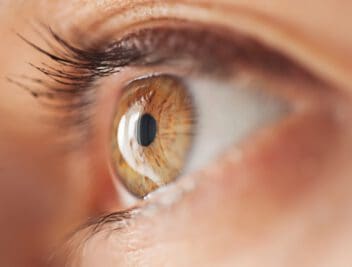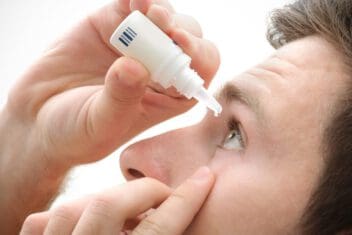Shingles in the Eye and Face: Treatments That Actually Work
Home / Eye Conditions & Eye Diseases /
Last Updated:
When you are released to your home, there are plenty of things you can do to ease your discomfort. The American Academy of Ophthalmology recommends:
- Cool compresses. A moist, damp towel placed over your closed eyes can relieve some of your pain.
- Painkillers. If your doctor agrees, you can use medications like aspirin to ease distress.
- Eye drops. Your doctor may suggest soothing drops to help your tissues knit back together.
Regardless of what you do at home, it’s crucial to stay in touch with your doctor as you heal. The infection is serious, and it pays to work with a professional to heal properly. Don’t attempt to treat the issue at home on your own without professional medical supervision.
Table of Contents
Your body is crisscrossed with a network of nerves. After a bout of chickenpox, the virus that causes the condition can retreat into that nerve network. When one nerve branch is irritated by the chickenpox virus, it causes blisters. That outbreak is known as shingles.
In most people, the shingles blisters wrap around one side of the torso. But the blisters can appear on the face instead.
Shingles can also strike your eyes, and when that happens, it’s a medical emergency. The outbreak can cause temporary vision problems, and without treatment, those losses can become permanent.
Antiviral medication can help to reduce your symptoms and ease discomfort, but you will need to start treatment as soon as outbreaks begin. At-home care, including using cool compresses, may also be helpful.
If you’ve had chickenpox, you are at risk for shingles. A vaccine can help to reduce your likelihood of facing serious shingles complications.
What You Should Know About Shingles

You may not remember having the itchy, painful welts caused by chickenpox. But according to the Centers for Disease Control and Prevention (CDC), 99.5 percent of people born before 1980 were infected at one point or another. Anyone who has been infected is at risk for shingles.
When chickenpox infections fade, the virus that caused them does not. Chickenpox is caused by the varicella-zoster virus (VZV), and it’s a member of the herpes family. Like most herpes-based illnesses, VZV never really goes away. Instead, it lies dormant within your body.
You deserve clear vision. We can help.
With 135+ locations and over 2.5 million procedures performed, our board-certified eye surgeons deliver results you can trust.
Your journey to better vision starts here.
VZV rests within your nerves, and during a shingles outbreak, the virus triggers inflammation and pain along a nerve band. The CDC says one in three people will get shingles. Most have just one outbreak, but some have repeated problems.
Mayo Clinic says shingles can cause more than pain. The condition can also cause:
- Persistent fatigue.
- Fever.
- Headache.
- Sensitivity to light.
Typically, people with shingles will experience blisters along just one small area that wraps around the torso. But any part of the body served by nerves can get hit with shingles. Symptoms last for about two weeks before fading away.
When Shingles Strikes Your Face
Dozens of muscles line your face, and they help you talk, eat, blink, and wink. All those movements start with nerve impulses, and any nerve band can get hit with a shingles outbreak.
Just one side of the face is touched by the issue, and the blisters will not spread. If you touch the bumps on one side of your face and then touch the other, you can’t spread the problem around. The virus sits within the nerves, far below the skin, and you can’t influence how the infection spreads.
Your shingles may appear on or around your eyelid, and that can make blinking difficult or painful. Sometimes, the tissues swell, and that makes it hard for you to open your eye.
Diagnosis
When you think it’s likely that rashes on your face are because of shingles, the American Academy of Dermatology Association (AAD) recommends you seek care within three days to prevent long-term complications such as chronic nerve pain (postherpetic neuralgia).
After taking a comprehensive medical history, a dermatologist will examine the skin rash to determine whether you have shingles or another condition. Typically, the doctor asks questions about your symptoms, such as weakness or fever preceding the development of rashes. Shingles may occur several years after treating chickenpox but tends to be painful or itchy.
Rashes initially appear as small red dots that later blister and crust along specific dermatomes. Your doctor will scrape fluid from the blister and send it to the lab for visualization under a high-powered microscope. If the fluid contains the shingles virus, it’s confirmation of shingles disease.
Doctors also rely on the polymerase chain reaction, another laboratory test, to confirm a diagnosis. Other tests that can help your doctor diagnose shingles include:
- Direct fluorescent antibody
- Tzanck smear
- Serological tests
Serological tests little specificity and are not ideal for diagnosing shingles.
Shingles Can Harm Your Eyes

Eyelid shingles can impact your vision and your comfort. But shingles can do even more. The virus can spread to tissues within the eye, and that can cause additional damage.
Researchers say 1 person in 100 can develop the ophthalmic version of shingles, and most who do are elderly. If you have the condition, you may visit your doctor complaining of:
- Vision changes.
- Pain.
- Redness in your eye.
- Welts around your eye.
It’s important to get help right away when shingles appears in your eye, says Mayo Clinic. Shingles can cause longstanding problems with your vision, and in some cases, it can cause blindness. The sooner you act, the better.
You will probably be encouraged to get help, experts say, as shingles within the eye are excruciating. You might describe the pain as itchy, burning, or stabbing. It does not get better if you blink or rest. And it may feel worse with each passing day.
Shingles brings more than just extreme discomfort to the eyes. It can also weaken the structures within the eye, and that can increase your risk of other eye health problems. The American Academy of Ophthalmology says a case of shingles can up your risk of developing these issues:
- Glaucoma
- Cataracts
- Double vision
If the welts appear on your cornea, they can leave scars behind. Those marks can blur your vision for years to come.
You deserve clear vision. We can help.
With 135+ locations and over 2.5 million procedures performed, our board-certified eye surgeons deliver results you can trust.
Your journey to better vision starts here.
How Eye Shingles Are Treated

You do not have to endure shingles. With the help of your doctor, you can overcome the discomfort and help the outbreak to heal. You can also take some steps to reduce the frequency and severity of your outbreaks.
The key is to get help within three days of the start of an outbreak. That is the moment at which your immune system is still strong but could use a little boost. Antiviral medications can tamp down the virus and send it back to the nerve root, so you will feel a bit more comfortable.
You will still be at risk for future outbreaks, as shingles can’t be cured. But the treatment can keep the excruciating pain and damage at bay.
Your doctor may ask you to spend a few days in the hospital. You will get around-the-clock care for your outbreak, and your doctor can watch the infection carefully and step in if sight-stealing complications appear.
When you are released to your home, there are plenty of things you can do to ease your discomfort. The American Academy of Ophthalmology recommends:
- Cool compresses. A moist, damp towel placed over your closed eyes can relieve some of your pain.
- Painkillers. If your doctor agrees, you can use medications like aspirin to ease distress.
- Eye drops. Your doctor may suggest soothing drops to help your tissues knit back together.
Regardless of what you do at home, it’s crucial to stay in touch with your doctor as you heal. The infection is serious, and it pays to work with a professional to heal properly. Don’t attempt to treat the issue at home on your own without professional medical supervision.
How Long Does Shingles in the Eye Last?
Generally, shingles in the eye lasts around three to five weeks from the initial onset of symptoms to the clearing of the rash. However, the severity and potential complications can vary, influencing its duration.
- Initial Symptoms: The initial symptoms, such as burning, tingling, or pain, typically manifest within the first week. This is often accompanied by the appearance of a rash and the subsequent development of fluid-filled blisters.
- Rash Progression: Over the next few days to a week, these blisters will dry up, forming crusty scabs, which then clear up over a couple of weeks.
- Potential Complications: While the primary symptoms of ophthalmic shingles might conclude within the typical three to five weeks, complications related to the eye can persist. The persistence is especially true for untreated cases or cases where treatment might have been delayed. Such complications include corneal scarring, which can blur vision for an extended period, or other severe conditions that can even lead to permanent vision loss.
- Post-Infection Concerns: Some patients might experience prolonged pain, discomfort, or vision disturbances beyond the immediate shingles episode. This is a reminder of the importance of timely and appropriate treatment to prevent such lasting complications.
Can You Prevent Shingles?
Shingles are caused by an outbreak of the chickenpox virus. You have two avenues to follow that lead to prevention, including avoidance and vaccines.
If you’ve never been exposed to the chickenpox virus, prevention is critical. That means you should avoid:
- Anyone with active chickenpox. The puss inside the chickenpox holds the virus, and it’s very contagious. Steer clear of anyone who has been diagnosed. Chickenpox is considered to be more contagious than shingles.
- Anyone with shingles. You can get shingles from someone with an outbreak, although it’s rare. If you’ve never been exposed, do not take a chance.
- If the outbreak is in the blister phase, the person is contagious. Once the blisters crust over, the person is no longer contagious. If the person keeps their rash and blisters covered, the risk of spreading the virus is low.
Some people are more susceptible to contracting the virus. This includes people with certain autoimmune conditions as well as those with other conditions that suppress the immune system. People who take certain immunosuppressive medications are also at a higher risk.
Adults 50 and older can use a vaccine for protection. Experts agree that the vaccine is not perfect, and some people who get it still get sick later. But it can reduce your risk of an outbreak. Your doctor can tell you whether you should get it and when.
Aside from vaccination and avoidance, there is no other way to prevent shingles from attacking your body. But remember that if you notice tingling or pain along a nerve band, your doctor can help. Ask about the symptoms you see and get help as soon as you can.
FAQs About Shingles
How long does it last?
In most cases, the varicella infection lasts between three to five weeks. Shingles usually begin with a burning or tingling and painful sensation on one side of the body. Some individuals also experience numbness and itching. Within one week, the sensations disappear, and small red rashes follow.
The rash turns into a fluid-containing blister, dries up within the next few days, and crusts to form scabs. In a couple of weeks, even the scab clears. However, long-term complications can occur and prolong shingles without timely treatment.
What can be mistaken for shingles?
Other skin conditions manifesting with rashes such as hives, eczema and psoriasis can be mistaken for shingles. Dermatologists look at the different characteristics of the rash to identify the cause. For instance, raised and welt-like rashes result from hives, while psoriasis manifests with red patches having white scales. Both differ from shingles that begin with small red spots, which blister and crust.
What triggers a shingles outbreak?
After an episode of chickenpox, the virus (Varicella zoster) remains dormant in the body, hiding within the nerves. As long as your immunity is strong, the infection remains suppressed. A compromise of your immune system, whether due to disease or other causes like aging, leads to virus reactivation. The result is a shingles rash that is quite painful.
You deserve clear vision. We can help.
With 135+ locations and over 2.5 million procedures performed, our board-certified eye surgeons deliver results you can trust.
Your journey to better vision starts here.
References
- Shingles (Herpes Zoster). (August 2019). Centers for Disease Control and Prevention.
- Shingles Burden and Trends. (August 2019). Centers for Disease Control and Prevention.
- Shingles. (May 2018). Mayo Clinic.
- How to Treat Shingles on the Face. Medical News Today.
- Managing Ophthalmic Herpes Zoster in Primary Care. (July 2005). BMJ.
- Mayo Clinic Minute: What Are Eye Shingles? (April 2019). Mayo Clinic.
- Shingles of the Eye Cases Are on the Rise. (May 2019). AARP.
- Shingles (Herpes Zoster) Symptoms. (October 2019). American Academy of Ophthalmology.
- Shingles. (October 2018). National Institute on Aging.
- Shingles (Herpes Zoster) Treatment. (October 2019). American Academy of Ophthalmology.
- 3 Things You Can Do About Shingles. (August 2016). Harvard Medical School.
- Shingles (Herpes Zoster): Diagnosis & Testing. (September 19, 2019). Centers for Disease Control and Prevention.
- Shingles. (October 12, 2021). National Institute on Aging.
This content is for informational purposes only. It may have been reviewed by a licensed physician, but is not intended to serve as a substitute for professional medical advice. Always consult your healthcare provider with any health concerns. For more, read our Privacy Policy and Editorial Policy.
